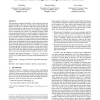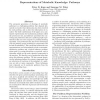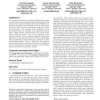123
click to vote
CVPR
2012
IEEE
13 years 3 months ago
2012
IEEE
Structure from motion (SFM) aims at jointly recovering the structure of a scene as a collection of 3D points and estimating the camera poses from a number of input images. In this...
130
click to vote
KDD
2012
ACM
13 years 3 months ago
2012
ACM
Trust networks, where people leave trust and distrust feedback, are becoming increasingly common. These networks may be regarded as signed graphs, where a positive edge weight cap...
123
click to vote
JMLR
2012
13 years 3 months ago
2012
Often when modeling structured domains, it is desirable to leverage information that is not naturally expressed as simply a label. Examples include knowledge about the evaluation ...
PLDI
2012
ACM
13 years 3 months ago
2012
ACM
When program verification tools fail to verify a program, either the program is buggy or the report is a false alarm. In this situation, the burden is on the user to manually cla...
118
click to vote
SIGKDD
2002
15 years 18 days ago
2002
In this paper, we describe the threats to privacy that can occur through data mining and then view the privacy problem as a variation of the inference problem in databases. Keywor...
121
click to vote
ISMB
1994
15 years 2 months ago
1994
The automatic generation of drawings of metabolic pathways is a challenging problem that depends intimately on exactly what information has been recorded for each pathway, and on ...
UAI
2008
15 years 2 months ago
2008
Many algorithms and applications involve repeatedly solving variations of the same inference problem; for example we may want to introduce new evidence to the model or perform upd...
118
click to vote
GECCO
2006
Springer
15 years 4 months ago
2006
Springer
In this paper, we address the problem of finding gene regulatory networks from experimental DNA microarray data. We focus on the evaluation of the performance of different evoluti...
137
click to vote
GECCO
2006
Springer
15 years 4 months ago
2006
Springer
In this paper we address the problem of finding gene regulatory networks from experimental DNA microarray data. We focus on the evaluation of the performance of different mathemat...
110
click to vote
COLT
1999
Springer
15 years 5 months ago
1999
Springer
We present a unified framework for reasoning about worst-case regret bounds for learning algorithms. This framework is based on the theory of duality of convex functions. It brin...



